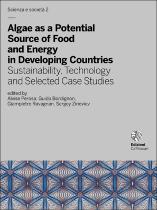JavaScript is disabled for your browser. Some features of this site may not work without it.
- ResearchSpace
- →
- Research Publications/Outputs
- →
- Book Chapters
- →
- View Item
| dc.contributor.author |
Chinnasamy, S

|
|
| dc.contributor.author |
Maharajh, Dheepak M

|
|
| dc.contributor.author |
Rajendran, L

|
|
| dc.contributor.author |
Bhaskar, S

|
|
| dc.contributor.author |
Ratha, SK

|
|
| dc.contributor.author |
Rengasamy, R

|
|
| dc.date.accessioned | 2016-10-26T12:22:57Z | |
| dc.date.available | 2016-10-26T12:22:57Z | |
| dc.date.issued | 2015-03 | |
| dc.identifier.citation | Chinnasamy, S., Maharajh, D., Rajendran, L., Bhaskar, S., Ratha, S.K. and Rengasamy, R. 2015. Overview of Microalgae Production Technologies. In: Algae as a potential source of food and every energy in developing countries sustainability, technology and selected case studies. Edizioni Ca’Foscari Publishing: Venice, Italy, 87-98 | en_US |
| dc.identifier.isbn | 978-88-6969-004-4 | |
| dc.identifier.uri | http://virgo.unive.it/ecf-workflow/upload_pdf/ScienSoc_2_DIGITALE.pdf | |
| dc.identifier.uri | http://hdl.handle.net/10204/8852 | |
| dc.description | Copyright: Edizioni Ca’Foscari Publishing: Venice, Italy. | en_US |
| dc.description.abstract | Microalgae are fast becoming a favoured feedstock for the production of advanced biofuels including biodiesel, biocrude, bioethanol, biomethane, green diesel and biojet fuels. Algae for their growth require sunlight, COfrom waste streams, unproductive lands and poor quality waters which include seawater, brackish water and agricultural, municipal and industrial wastewaters. Algae biomass is rich in lipids, carbohydrates and proteins. Currently more emphasis is given to extract lipids from the algal biomass to produce drop-in fuels. Algae can be cultivated through photoautotrophic and mixotrophic mode of nutrition using open raceway ponds and photobioreactors (PBRs). Heterotrophic mode of nutrition requires closed bioreactors and needs organic carbon sources which may prove to be costly for biofuels production. Harvesting of algae is a major energy consuming process in the fuel production path. Techniques such as centrifugation, filtration, flocculation, flotation and electrocoagulation-flocculation are assessed for their energy efficiency and cost effectiveness for commercial-scale operations. Downstream processing of algal biomass including cell disruption and extraction requires innovative technologies. This book chapter discusses algae biomass cultivation, harvesting, cell disruption (techniques such as bead beating, sonication, and pulsed electric field) and extraction technologies (using solvents, ionic liquids, subcritical and supercritical fluids) in great detail for biofuel production. | en_US |
| dc.language.iso | en | en_US |
| dc.publisher | Edizioni Ca’Foscari Publishing | en_US |
| dc.relation.ispartofseries | Workflow;15291 | |
| dc.subject | Biocrude | en_US |
| dc.subject | Biofuel | en_US |
| dc.subject | Bio-oil | en_US |
| dc.subject | Hydrothermal liquefaction | en_US |
| dc.subject | Ionic liquids | en_US |
| dc.subject | Microalgae | en_US |
| dc.subject | Milking | en_US |
| dc.subject | Oil | en_US |
| dc.subject | Subcritical water extraction | en_US |
| dc.subject | Supercritical fluid extraction | en_US |
| dc.title | Overview of Microalgae Production Technologies | en_US |
| dc.type | Book Chapter | en_US |
| dc.identifier.apacitation | Chinnasamy, S., Maharajh, D. M., Rajendran, L., Bhaskar, S., Ratha, S., & Rengasamy, R. (2015). Overview of Microalgae Production Technologies., <i>Workflow;15291</i> Edizioni Ca’Foscari Publishing. http://hdl.handle.net/10204/8852 | en_ZA |
| dc.identifier.chicagocitation | Chinnasamy, S, Dheepak M Maharajh, L Rajendran, S Bhaskar, SK Ratha, and R Rengasamy. "Overview of Microalgae Production Technologies" In <i>WORKFLOW;15291</i>, n.p.: Edizioni Ca’Foscari Publishing. 2015. http://hdl.handle.net/10204/8852. | en_ZA |
| dc.identifier.vancouvercitation | Chinnasamy S, Maharajh DM, Rajendran L, Bhaskar S, Ratha S, Rengasamy R. Overview of Microalgae Production Technologies.. Workflow;15291. [place unknown]: Edizioni Ca’Foscari Publishing; 2015. [cited yyyy month dd]. http://hdl.handle.net/10204/8852. | en_ZA |
| dc.identifier.ris | TY - Book Chapter AU - Chinnasamy, S AU - Maharajh, Dheepak M AU - Rajendran, L AU - Bhaskar, S AU - Ratha, SK AU - Rengasamy, R AB - Microalgae are fast becoming a favoured feedstock for the production of advanced biofuels including biodiesel, biocrude, bioethanol, biomethane, green diesel and biojet fuels. Algae for their growth require sunlight, COfrom waste streams, unproductive lands and poor quality waters which include seawater, brackish water and agricultural, municipal and industrial wastewaters. Algae biomass is rich in lipids, carbohydrates and proteins. Currently more emphasis is given to extract lipids from the algal biomass to produce drop-in fuels. Algae can be cultivated through photoautotrophic and mixotrophic mode of nutrition using open raceway ponds and photobioreactors (PBRs). Heterotrophic mode of nutrition requires closed bioreactors and needs organic carbon sources which may prove to be costly for biofuels production. Harvesting of algae is a major energy consuming process in the fuel production path. Techniques such as centrifugation, filtration, flocculation, flotation and electrocoagulation-flocculation are assessed for their energy efficiency and cost effectiveness for commercial-scale operations. Downstream processing of algal biomass including cell disruption and extraction requires innovative technologies. This book chapter discusses algae biomass cultivation, harvesting, cell disruption (techniques such as bead beating, sonication, and pulsed electric field) and extraction technologies (using solvents, ionic liquids, subcritical and supercritical fluids) in great detail for biofuel production. DA - 2015-03 DB - ResearchSpace DP - CSIR KW - Biocrude KW - Biofuel KW - Bio-oil KW - Hydrothermal liquefaction KW - Ionic liquids KW - Microalgae KW - Milking KW - Oil KW - Subcritical water extraction KW - Supercritical fluid extraction LK - https://researchspace.csir.co.za PY - 2015 SM - 978-88-6969-004-4 T1 - Overview of Microalgae Production Technologies TI - Overview of Microalgae Production Technologies UR - http://hdl.handle.net/10204/8852 ER - | en_ZA |






